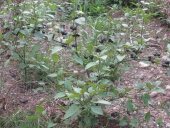
 1
1




"We're all just walking each other home." -Ram Dass
"Be a lamp, or a lifeboat, or a ladder."-Rumi
"It's all one song!" -Neil Young
 1
1




We can green the world through random acts of planting.




"We're all just walking each other home." -Ram Dass
"Be a lamp, or a lifeboat, or a ladder."-Rumi
"It's all one song!" -Neil Young
 1
1




Pecan Media: food forestry and forest garden ebooks
Now available: The Native Persimmon (centennial edition)




Dan Boone wrote:I got a packet of these seeds (labelled with their other common name of Sunberry) from Seed Savers Exchange this winter. Planning to try them out even though nobody much seems enthusiastic about the fruit. I do have a ton of cardinals hanging around, so at least somebody will be happy!

"We're all just walking each other home." -Ram Dass
"Be a lamp, or a lifeboat, or a ladder."-Rumi
"It's all one song!" -Neil Young





Pecan Media: food forestry and forest garden ebooks
Now available: The Native Persimmon (centennial edition)
 1
1




 1
1




How did you start them? I have heard to do them like tomatoes, but I have 1000 seeds. I am considering winter sewing, or direct sewing, what do you think?

"We're all just walking each other home." -Ram Dass
"Be a lamp, or a lifeboat, or a ladder."-Rumi
"It's all one song!" -Neil Young
 1
1




Freakin' hippies and Squares, since 1986
 1
1









Zach Muller wrote:
Dan, this would actually work to clear out grass in a certain diameter, but you would possibly be left with a lot of seeds ready to sprout.
Pecan Media: food forestry and forest garden ebooks
Now available: The Native Persimmon (centennial edition)









Pecan Media: food forestry and forest garden ebooks
Now available: The Native Persimmon (centennial edition)








Dan Boone wrote:
I'm curious why you wanted the Horse Nettle? Its virtues have not yet revealed themselves to me.
 1
1




Maureen Atsali
Wrong Way Farm - Kenya
 1
1




 1
1




Maureen Atsali
Wrong Way Farm - Kenya
 1
1




 2
2









|
Evildoers! Eat my justice! And this tiny ad's justice too!
Play Your Way to a Sustainable Lifestyle: Uncover Permaculture Principles with Each Card
https://gardener-gift.com/
|






